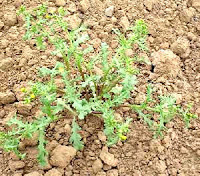GROUNDSEL, SENECIO VULGARIS
Groundsel gets its Latin name, Senecio vulgaris, from ‘senex’ meaning ‘old man’ and vulgaris, which means ‘common’. It is believed to have got this name from the appearance of the grey hairs on the seeds. The name groundsel comes from the Anglo-Saxon, “groundeswelge” which means “ground swallower” doubtless because of its ability to spread. One plant will produce around 1,200 seeds, with hairs which are dispersed by the wind and birds which love to eat them. It has been estimated that 85% of these seeds will germinate in the first year with 100 % germinating in a five-year period, so it is a very prolific stubborn weed to remove once it has occupied an area. It is in flower between May and October. It is a member of the Asteraceae or daisy family of plants.
It has numerous other names, including Old-Man-in-the-Spring, birdseed, chickenweed, grinsel and grundsel to mention just a few. It is an invasive alien species in North America and probably arrived on its shores in sacks of grain seed, but it is native to Europe , North Africa , and parts of Asia . It has mainly been used for chickenfeed and for birdseed - the Victorians fed their canaries on it in Britain
It is said that the leaves can be eaten raw or cooked by humans, but perhaps this is not advisable. The Anglo-Saxons used groundsel medicinally in poultices with salt added to them.
The 16th century English herbalist, John Gerard, recommended “the down of the flower mixed with vinegar” as a good dressing for fresh wounds. He also said that the juice of the plant, when boiled in ale could be used as a purgative with a little honey and vinegar added. It was believed that you had to dig up the roots without using any iron in the digging tool as it would then act as a remedy for wounds caused by iron. The roots were thought, if harvested in this way, to relieve headaches. It was also used as an emollient for chapped hands, with the whole plant chopped and boiling water poured over it and then allowed to infuse for half an hour. A strong infusion was used to produce vomiting and as a purgative.
Nicholas Culpeper, writing in the 17th century in his “Complete Herbal” had this to say of groundsel: -
“ This herb is Venus's mistress-piece, and is as gallant and universal a medicine for all diseases coming of heat, in what part of the body soever they be, as the sun shines upon; it is very safe and friendly to the body of man: yet causes vomiting if the stomach be afflicted; if not, purging: and it doth it with more gentleness than can be expected; it is moist, and something cold withal, thereby causing expulsion, and repressing the heat caused by the motion of the internal parts in purges and vomits…
The decoction of this herb (saith Dioscorides) made with wine, and drank, helps the pains of the stomach, proceeding of choler, (which it may well do by a vomit) as daily experience shews. The juice thereof taken in drink, or the decoction of it in ale, gently performs the same. It is good against the jaundice and falling sickness, being taken in wine; as also against difficulty of making water. It provokes urine, expels gravel in the reins or kidneys; a dram thereof given in oxymel, after some walking or stirring of the body. It helps also the sciatica, griping of the belly, the cholic, defects of the liver, and provokes women's courses. The fresh herb boiled, and made into a poultice, applied to the breasts of women that are swollen with pain and heat, as also the privy parts of man or woman, the seat or fundament, or the arteries, joints, and sinews, when they are inflamed and swollen, doth much ease them; and used with some salt, helps to dissolve knots or kernels in any part of the body. The juice of the herb, or as (Dioscorides saith) the leaves and flowers, with some fine Frankincensein powder, used in wounds of the body, nerves or sinews, doth singularly help to heal them. The distilled water of the herb performs well all the aforesaid cures, but especially for inflammations or watering of the eyes, by reason of the defluxion of rheum unto them.”
The whole herb should be picked in May or when it begins to come into flower, and dried for later use, or used fresh. However other herbs are less toxic than this one and so treat groundsel with care.








Hvad hedder det på dansk
ReplyDelete